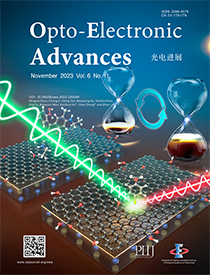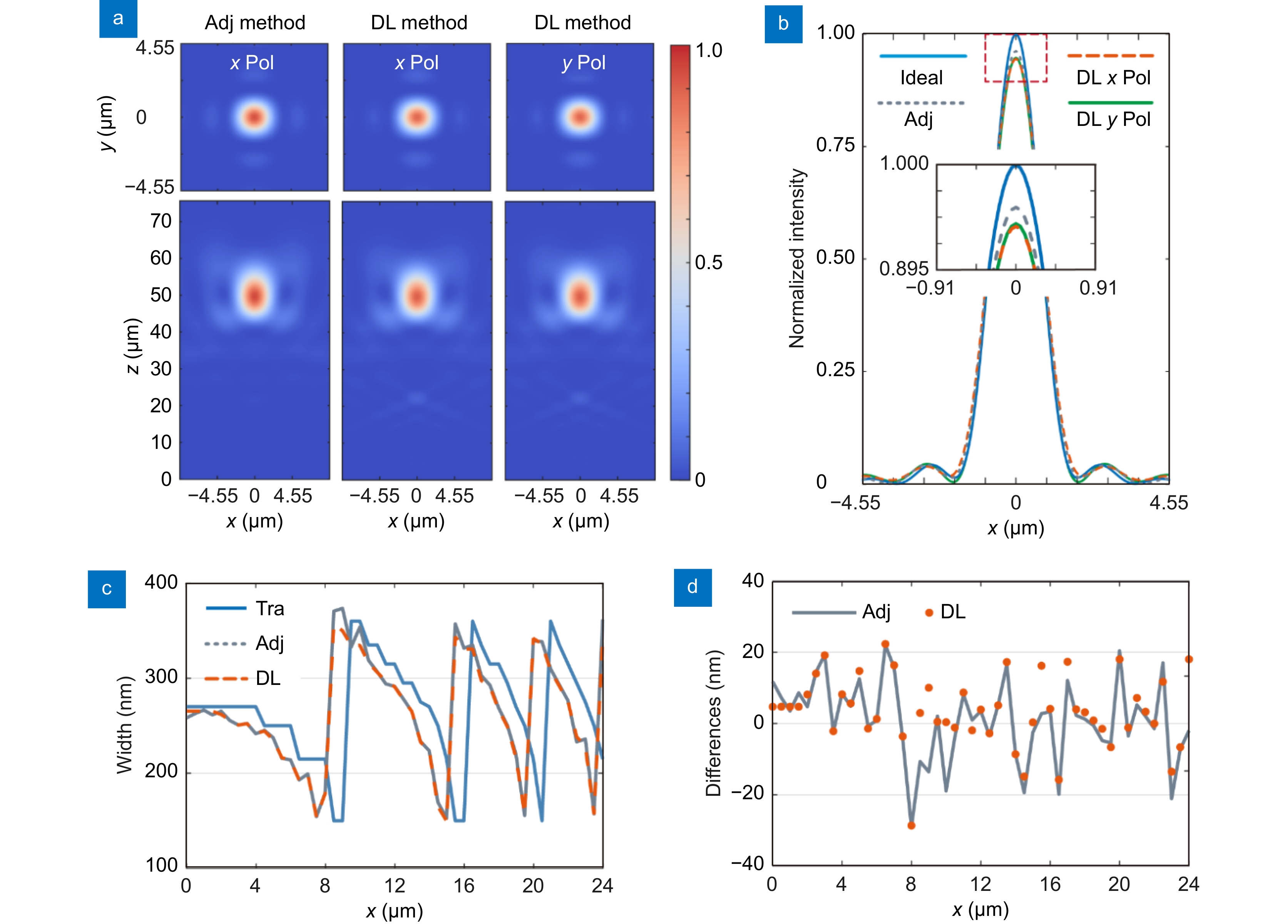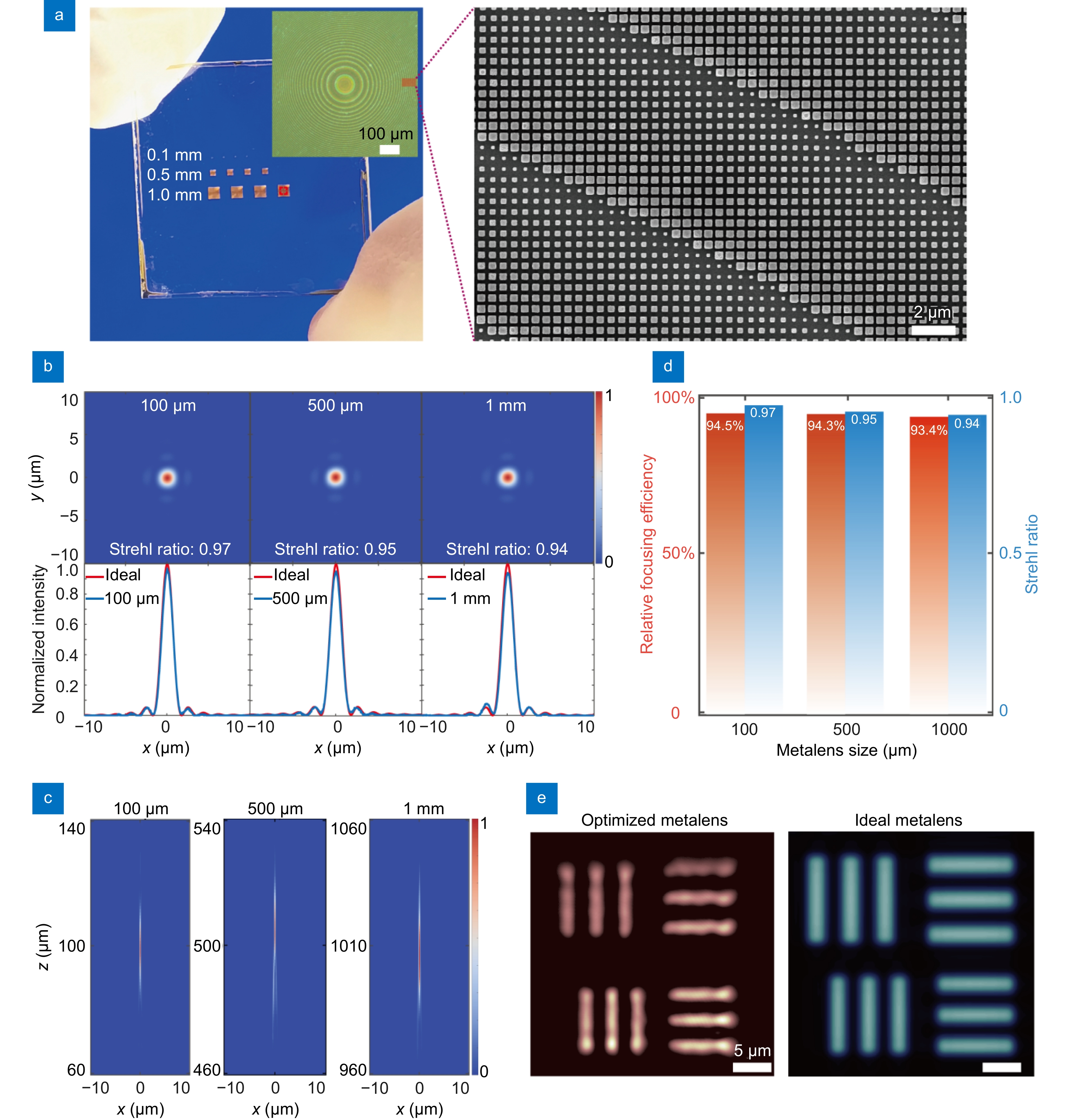| Citation: | Ha YL, Luo Y, Pu MB, Zhang F, He Q et al. Physics-data-driven intelligent optimization for large-aperture metalenses. Opto-Electron Adv 6, 230133 (2023). doi: 10.29026/oea.2023.230133 |
Physics-data-driven intelligent optimization for large-aperture metalenses
-
Abstract
Metalenses have gained significant attention and have been widely utilized in optical systems for focusing and imaging, owing to their lightweight, high-integration, and exceptional-flexibility capabilities. Traditional design methods neglect the coupling effect between adjacent meta-atoms, thus harming the practical performance of meta-devices. The existing physical/data-driven optimization algorithms can solve the above problems, but bring significant time costs or require a large number of data-sets. Here, we propose a physics-data-driven method employing an “intelligent optimizer” that enables us to adaptively modify the sizes of the meta-atom according to the sizes of its surrounding ones. The implementation of such a scheme effectively mitigates the undesired impact of local lattice coupling, and the proposed network model works well on thousands of data-sets with a validation loss of 3×10−3. Based on the “intelligent optimizer”, a 1-cm-diameter metalens is designed within 3 hours, and the experimental results show that the 1-mm-diameter metalens has a relative focusing efficiency of 93.4% (compared to the ideal focusing efficiency) and a Strehl ratio of 0.94. Compared to previous inverse design method, our method significantly boosts designing efficiency with five orders of magnitude reduction in time. More generally, it may set a new paradigm for devising large-aperture meta-devices. -

-
References
[1] Ren HR, Briere G, Fang XY, Ni PN, Sawant R et al. Metasurface orbital angular momentum holography. Nat Commun 10, 2986 (2019). doi: 10.1038/s41467-019-11030-1 [2] Zhang YX, Pu MB, Jin JJ, Lu XJ, Guo YH et al. Crosstalk-free achromatic full Stokes imaging polarimetry metasurface enabled by polarization-dependent phase optimization. Opto-Electron Adv 5, 220058 (2022). doi: 10.29026/oea.2022.220058 [3] Fu R, Chen KX, Li ZL, Yu SH, Zheng GX. Metasurface-based nanoprinting: principle, design and advances. Opto-Electron Sci 1, 220011 (2022). doi: 10.29026/oes.2022.220011 [4] Zhang XD, Liu YL, Han JC, Kivshar Y, Song QH. Chiral emission from resonant metasurfaces. Science 377, 1215–1218 (2022). doi: 10.1126/science.abq7870 [5] Zhou JX, Liu SK, Qian HL, Li YH, Luo HL et al. Metasurface enabled quantum edge detection. Sci Adv 6, eabc4385 (2020). doi: 10.1126/sciadv.abc4385 [6] Luo XG, Zhang F, Pu MB, Xu MF. Catenary optics: a perspective of applications and challenges. J Phys:Condens Matter 34, 381501 (2022). doi: 10.1088/1361-648X/ac808e [7] Xie X, Pu MB, Jin JJ, Xu MF, Guo YH et al. Generalized pancharatnam-berry phase in rotationally symmetric meta-atoms. Phys Rev Lett 126, 183902 (2021). doi: 10.1103/PhysRevLett.126.183902 [8] Shen Y, Luo XG. Efficient bending and focusing of light beam with all-dielectric subwavelength structures. Opt Commun 366, 174–178 (2016). doi: 10.1016/j.optcom.2015.12.043 [9] Wang YL, Fan QB, Xu T. Design of high efficiency achromatic metalens with large operation bandwidth using bilayer architecture. Opto-Electron Adv 4, 200008 (2021). doi: 10.29026/oea.2021.200008 [10] Ogawa C, Nakamura S, Aso T, Ikezawa S, Iwami K. Rotational varifocal moiré metalens made of single-crystal silicon meta-atoms for visible wavelengths. Nanophotonics 11, 1941–1948 (2022). doi: 10.1515/nanoph-2021-0690 [11] Zhang F, Pu MB, Li X, Ma XL, Guo YH et al. Extreme‐angle silicon infrared optics enabled by streamlined surfaces. Adv Mater 33, 2008157 (2021). doi: 10.1002/adma.202008157 [12] Georgi P, Wei QS, Sain B, Schlickriede C, Wang YT et al. Optical secret sharing with cascaded metasurface holography. Sci Adv 7, eabf9718 (2021). doi: 10.1126/sciadv.abf9718 [13] Khaliq HS, Kim J, Naeem T, Riaz K, Badloe T et al. Broadband chiro‐optical effects for futuristic meta‐holographic displays. Adv Opt Mater 10, 2201175 (2022). doi: 10.1002/adom.202201175 [14] Gao H, Fan XH, Xiong W, Hong MH. Recent advances in optical dynamic meta-holography. Opto-Electron Adv 4, 210030 (2021). doi: 10.29026/oea.2021.210030 [15] Jin JJ, Pu MB, Wang YQ, Li X, Ma XL et al. Multi-channel vortex beam generation by simultaneous amplitude and phase modulation with two-dimensional metamaterial. Adv Mater Technol 2, 1600201 (2017). doi: 10.1002/admt.201600201 [16] Fang XY, Ren HR, Gu M. Orbital angular momentum holography for high-security encryption. Nat Photonics 14, 102–108 (2020). doi: 10.1038/s41566-019-0560-x [17] Zhang F, Guo YH, Pu MB, Chen LW, Xu MF et al. Meta-optics empowered vector visual cryptography for high security and rapid decryption. Nat Commun 14, 1946 (2023). doi: 10.1038/s41467-023-37510-z [18] Yu NF, Genevet P, Kats MA, Aieta F, Tetienne JP et al. Light propagation with phase discontinuities: generalized laws of reflection and refraction. Science 334, 333–337 (2011). doi: 10.1126/science.1210713 [19] Wang SM, Wu PC, Su VC, Lai YC, Hung Chu C et al. Broadband achromatic optical metasurface devices. Nat Commun 8, 187 (2017). doi: 10.1038/s41467-017-00166-7 [20] Liang HW, Lin QL, Xie XS, Sun Q, Wang Y et al. Ultrahigh numerical aperture metalens at visible wavelengths. Nano Lett 18, 4460–4466 (2018). doi: 10.1021/acs.nanolett.8b01570 [21] Ha YL, Guo YH, Pu MB, Xu MF, Li X et al. Meta-optics-empowered switchable integrated mode converter based on the adjoint method. Nanomaterials 12, 3395 (2022). doi: 10.3390/nano12193395 [22] Pan MY, Fu YF, Zheng MJ, Chen H, Zang YJ et al. Dielectric metalens for miniaturized imaging systems: progress and challenges. Light Sci Appl 11, 195 (2022). doi: 10.1038/s41377-022-00885-7 [23] Xu MF, He Q, Pu MB, Zhang F, Li L et al. Emerging long‐range order from a freeform disordered metasurface. Adv Mater 34, 2108709 (2022). doi: 10.1002/adma.202108709 [24] Qi HX, Du ZC, Hu XY, Yang JY, Chu SS et al. High performance integrated photonic circuit based on inverse design method. Opto-Electron Adv 5, 210061 (2022). doi: 10.29026/oea.2022.210061 [25] Liu XY, Chen MK, Chu CH, Zhang JC, Leng BR et al. Underwater binocular meta-lens. ACS Photonics 10, 2382–2389 (2023). doi: 10.1021/acsphotonics.2c01667 [26] Chen MK, Liu XY, Wu YF, Zhang JC, Yuan JQ et al. A meta-device for intelligent depth perception. Adv Mater 35, 2107465 (2023). doi: 10.1002/adma.202107465 [27] Chen MK, Liu XY, Sun YN, Tsai DP. Artificial intelligence in meta-optics. Chem. Rev 122, 15356–15413 (2022). doi: 10.1021/acs.chemrev.2c00012 [28] Dory C, Vercruysse D, Yang KY, Sapra NV, Rugar AE et al. Inverse-designed diamond photonics. Nat Commun 10, 3309 (2019). doi: 10.1038/s41467-019-11343-1 [29] Cai HG, Srinivasan S, Czaplewski DA, Martinson ABF, Gosztola DJ et al. Inverse design of metasurfaces with non-local interactions. npj Comput Mater 6, 116 (2020). doi: 10.1038/s41524-020-00369-5 [30] Chung H, Miller OD. High-NA achromatic metalenses by inverse design. Opt Express 28, 6945–6965 (2020). doi: 10.1364/OE.385440 [31] Lalau-Keraly CM, Bhargava S, Miller OD, Yablonovitch E. Adjoint shape optimization applied to electromagnetic design. Opt Express 21, 21693–21701 (2013). doi: 10.1364/OE.21.021693 [32] Nam SH, Kim M, Kim N, Cho D, Choi M et al. Photolithographic realization of target nanostructures in 3D space by inverse design of phase modulation. Sci Adv 8, eabm6310 (2022). doi: 10.1126/sciadv.abm6310 [33] Mansouree M, McClung A, Samudrala S, Arbabi A. Large-scale parametrized metasurface design using adjoint optimization. ACS Photonics 8, 455–463 (2021). [34] Sang D, Xu MF, Pu MB, Zhang F, Guo YH et al. Toward high-efficiency ultrahigh numerical aperture freeform metalens: from vector diffraction theory to topology optimization. Laser Photonics Rev 16, 2200265 (2022). doi: 10.1002/lpor.202200265 [35] Li ZY, Pestourie R, Park JS, Huang YW, Johnson SG et al. Inverse design enables large-scale high-performance meta-optics reshaping virtual reality. Nat Commun 13, 2409 (2022). doi: 10.1038/s41467-022-29973-3 [36] Sell D, Yang JJ, Doshay S, Yang R, Fan JA. Large-angle, multifunctional metagratings based on freeform multimode geometries. Nano Lett 17, 3752–3757 (2017). doi: 10.1021/acs.nanolett.7b01082 [37] Xu MF, Pu MB, Sang D, Zheng YH, Li X et al. Topology-optimized catenary-like metasurface for wide-angle and high-efficiency deflection: from a discrete to continuous geometric phase. Opt Express 29, 10181–10191 (2021). doi: 10.1364/OE.422112 [38] Yang JJ, Fan JA. Topology-optimized metasurfaces: impact of initial geometric layout. Opt Lett 42, 3161–3164 (2017). doi: 10.1364/OL.42.003161 [39] Ma TG, Tobah M, Wang HZ, Guo LJ. Benchmarking deep learning-based models on nanophotonic inverse design problems. Opto-Electron Sci 1, 210012 (2022). doi: 10.29026/oes.2022.210012 [40] Zhelyeznyakov MV, Brunton SL, Majumdar A. Deep learning to accelerate Maxwell's equations for inverse design of dielectric metasurfaces. In Proceedings of 2021 Conference on Lasers and Electro-Optics 1–2 (IEEE, 2020). [41] An SS, Zheng BW, Shalaginov MY, Tang H, Li H et al. Deep convolutional neural networks to predict mutual coupling effects in metasurfaces. Adv Opt Mater 10, 2102113 (2022). doi: 10.1002/adom.202102113 [42] Lin Z, Roques-Carmes C, Pestourie R, Soljačić M, Majumdar A et al. End-to-end nanophotonic inverse design for imaging and polarimetry. Nanophotonics 10, 1177–1187 (2021). doi: 10.1515/nanoph-2020-0579 [43] Yeung C, Tsai JM, King B, Pham B, Ho D et al. Multiplexed supercell metasurface design and optimization with tandem residual networks. Nanophotonics 10, 1133–1143 (2021). doi: 10.1515/nanoph-2020-0549 [44] Krasikov S, Tranter A, Bogdanov A, Kivshar Y. Intelligent metaphotonics empowered by machine learning. Opto-Electron Adv 5, 210147 (2022). doi: 10.29026/oea.2022.210147 [45] Ma W, Liu ZC, Kudyshev ZA, Boltasseva A, Cai WS et al. Deep learning for the design of photonic structures. Nat Photonics 15, 77–90 (2021). doi: 10.1038/s41566-020-0685-y [46] Qiu TS, Shi X, Wang JF, Li YF, Qu SB et al. Deep learning: a rapid and efficient route to automatic metasurface design. Adv Sci 6, 1900128 (2019). doi: 10.1002/advs.201900128 [47] Jiang JQ, Chen MK, Fan JA. Deep neural networks for the evaluation and design of photonic devices. Nat Rev Mater 6, 679–700 (2021). [48] Qian C, Zheng B, Shen YC, Jing L, Li EP et al. Deep-learning-enabled self-adaptive microwave cloak without human intervention. Nat Photonics 14, 383–390 (2020). doi: 10.1038/s41566-020-0604-2 [49] Yang B, Ma DN, Liu WW, Choi DY, Li ZC et al. Deep-learning-based colorimetric polarization-angle detection with metasurfaces. Optica 9, 217–220 (2022). doi: 10.1364/OPTICA.449893 [50] Jiang JQ, Fan JA. Global optimization of dielectric metasurfaces using a physics-driven neural network. Nano Lett 19, 5366–5372 (2019). doi: 10.1021/acs.nanolett.9b01857 [51] Jiang JQ, Sell D, Hoyer S, Hickey J, Yang JJ et al. Free-form diffractive metagrating design based on generative adversarial networks. ACS Nano 13, 8872–8878 (2019). doi: 10.1021/acsnano.9b02371 [52] Ren HR, Shao W, Li Y, Salim F, Gu M. Three-dimensional vectorial holography based on machine learning inverse design. Sci Adv 6, eaaz4261 (2020). doi: 10.1126/sciadv.aaz4261 [53] Ma W, Xu YH, Xiong B, Deng L, Peng RW et al. Pushing the limits of functionality‐multiplexing capability in metasurface design based on statistical machine learning. Adv Mater 34, 2110022 (2022). doi: 10.1002/adma.202110022 [54] Ma W, Cheng F, Xu YH, Wen QL, Liu YM. Probabilistic representation and inverse design of metamaterials based on a deep generative model with semi‐supervised learning strategy. Adv Mater 31, 1901111 (2019). doi: 10.1002/adma.201901111 [55] So S, Rho J. Designing nanophotonic structures using conditional deep convolutional generative adversarial networks. Nanophotonics 8, 1255–1261 (2019). doi: 10.1515/nanoph-2019-0117 [56] Liu ZC, Zhu DY, Lee KT, Kim AS, Raju L et al. Compounding meta‐atoms into metamolecules with hybrid artificial intelligence techniques. Adv Mater 32, 1904790 (2020). doi: 10.1002/adma.201904790 [57] Kudyshev ZA, Kildishev AV, Shalaev VM, Boltasseva A. Machine-learning-assisted metasurface design for high-efficiency thermal emitter optimization. Appl Phys Rev 7, 021407 (2020). doi: 10.1063/1.5134792 [58] Lin X, Rivenson Y, Yardimci NT, Veli M, Luo Y et al. All-optical machine learning using diffractive deep neural networks. Science 361, 1004–1008 (2018). doi: 10.1126/science.aat8084 [59] Zhu DY, Liu ZC, Raju L, Kim AS, Cai WS. Building multifunctional metasystems via algorithmic construction. ACS Nano 15, 2318–2326 (2021). doi: 10.1021/acsnano.0c09424 [60] Phan T, Sell D, Wang EW, Doshay S, Edee K et al. High-efficiency, large-area, topology-optimized metasurfaces. Light Sci Appl 8, 48 (2019). doi: 10.1038/s41377-019-0159-5 [61] Pestourie R, Pérez-Arancibia C, Lin Z, Shin W, Capasso F et al. Inverse design of large-area metasurfaces. Opt Express 26, 33732–33747 (2018). doi: 10.1364/OE.26.033732 [62] Arbabi A, Horie Y, Ball AJ, Bagheri M, Faraon A. Subwavelength-thick lenses with high numerical apertures and large efficiency based on high-contrast transmitarrays. Nat Commun 6, 7069 (2015). doi: 10.1038/ncomms8069 [63] Pu MB, Guo YH, Li X, Ma XL, Luo XG. Revisitation of extraordinary young’s interference: from catenary optical fields to spin–orbit interaction in metasurfaces. ACS Photonics 5, 3198–3204 (2018). doi: 10.1021/acsphotonics.8b00437 [64] Luo XG, Pu MB, Guo YH, Li X, Zhang F et al. Catenary functions meet electromagnetic waves: opportunities and promises. Adv Opt Mater 8, 2001194 (2020). doi: 10.1002/adom.202001194 [65] Pu MB, Li X, Ma XL, Wang YQ, Zhao ZY et al. Catenary optics for achromatic generation of perfect optical angular momentum. Sci Adv 1, e1500396 (2015). doi: 10.1126/sciadv.1500396 [66] Aiazzi B, Alparone L, Baronti S, Selva M, Stefani L. Unsupervised estimation of signal-dependent CCD camera noise. EURASIP J Adv Signal Process 2012, 231 (2012). doi: 10.1186/1687-6180-2012-231 -
Supplementary Information
Supplementary information for Physics-data-driven intelligent optimization for large-aperture metalenses

-
Access History

Article Metrics
-
Figure 1.
Working principle of the “intelligent optimizer”. The “intelligent optimizer” incorporates both Adj and DL methods. Data-sets of the DL network are obtained from the small-aperture metalens optimized by the Adj method. Super meta-atoms of large-aperture metalens are fed into the network one by one. Output meta-atoms are spliced together to create a new metalens with improved focusing efficiency.
-
Figure 2.
Design method for the large-aperture metalens. (a) The differences in widths distribution for the meta-atoms before and after optimization. (b) The widths distribution of metalens, with the smooth region and rough region corresponding to translucent boxes I and II, respectively. (c) The optimized network framework consists of an A-network that expands the information space of sampled data, and the weak coupling strength structures are filtered by the I-network.
-
Figure 3.
Simulation results of Adj and DL methods. (a) Electric field distributions in the xy and xz planes designed by DL method for x- and y-polarized light, and the Adj method for x-polarized, respectively. (b) Electric intensity profiles of the focal spot designed by theory, Adj, and DL methods, respectively. (c) Width distributions of metalenses on y=0 plane (x>0) designed by the traditional (Tra), Adj, and the proposed methods, respectively. (d) Width differences between the initial metalens and the optimized metalenses designed by the Adj method and our methods.
-
Figure 4.
Experimental results of optimized metalenses. (a) The left image shows an overview of the device, with each diameter corresponding to four exposure doses. The inset is the optical microscope image. Scale bar: 100 µm. The right image is the scanning electron microscope image. Scale bar: 2 µm. (b) The first row shows the focal plane intensity distributions of the three metalenses (100.5 μm, 500 μm, and 1 mm, from left to right, respectively). The second row shows the normalized focal intensity along the x-axis at the focal plane of the three metalenses. (c) Focal intensity distributions in the xz plane at the three metalenses. (d) Relative focusing efficiencies and Strehl ratios of three metalenses. (e) Imaging results of elements #5 and #6 from group #7 of the USAF resolution target at 1 mm diameter optimized metalens (left) and 1 mm diameter ideal metalens (right). Scale bar: 5 µm.

 E-mail Alert
E-mail Alert RSS
RSS



 DownLoad:
DownLoad:





